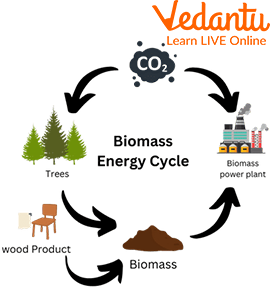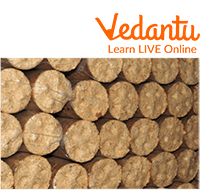




What Is Biomass? Definition, Types & Real-World Applications
Biomass refers to the total quantity of all living things in a particular area. The oldest fuel used by humans is biomass. In addition, it is also the most diverse. At present, it is also a clean and efficient source of heat and electricity generation. As the importance of renewable energy is increasing, the production of Biomass is also increasing.
Biomass is used as a fuel to generate heat and electricity. It is considered as a plant based material. Examples of biomass are wood, waste from households etc. Let’s now see it in detail.

Biomass
Biomass Fun Facts
One sort of organic material that can be utilised as a source of energy is biomass. Biomass can be used as a direct source of energy through combustion or in a converted form such as biofuel.
There are various ways to convert Biomass to biofuel, including biochemical, thermal and chemical.
The largest type of Biomass is still wood, but Biomass can be grown from sugarcane, sorghum, willow, poplar, maize, hemp and a variety of tree species.
There are two major categories of Biomass which include first-generation biofuels which involve fermenting sugar from one source into bioethanol, and second-generation biofuels which involve using municipal or agricultural water to make energy.

Biomass Energy Cycle
Biomass Energy
Biomass is also an important fuel for energy worldwide after coal, oil and natural gas. Biomass is renewable and free from total carbon dioxide emissions and is available in abundance on earth in the form of firewood, agricultural residues, cattle dung, urban waste etc.
The world's largest herd of cattle is in India. Therefore, there is a huge potential for the development of biogas. Biogas (methane or dung gas) is obtained by producing microbes by running the excretory materials of cattle in a digester at low temperatures. Biogas consists of 75 per cent methane gas which burns without producing smoke. Unlike wood, charcoal and coal, it does not leave any residue like ash after burning. In rural areas, it is used for cooking food and arranging lighting as fuel.
Biomass Briquettes
Briquettes made from Biomass are a biofuel substitute for coal and charcoal. Briquettes are mostly used in developing countries, where fuel for cooking is not readily available. Briquettes are increasingly being used in industrialised countries to heat industrial boilers that generate power from steam. The briquettes are combined with coal to make the heat supplied to the boiler.

Biomass Briquettes
Biomass Pellets
A pelletization mill creates Biomass pellets. The wood that is brought together here is inappropriate for use in other sectors, such as sawmill waste. The wood is broken down into chips, tested for quality, roasted to lower its moisture level to under 12%, and then powdered. The Biomass must first be cleansed to remove impurities before being converted into pellets. After that, the clean Biomass is chipped or crushed in a hammer mill to a consistent size that must be less than the thickness of the resulting pellet. Reducing the amount of horsepower required by the pellet mill by grinding the biomass
Biomass Power Plant
In Biomass power plants, wood or other waste is burned to create steam that powers a turbine and turns it into electricity or heats buildings and businesses. The main method for obtaining the majority of the electricity from Biomass is direct burning.
High-pressure steam is produced when Biomass is burned in a boiler. These turbine blades rotate as a result of the steam flowing over them. The rotation of the turbine powers a generator, which generates energy.
Summary
To conclude all the conceptual understanding regarding Biomass in this article we can say that as a food chain moves up from producers, the Biomass and energy contained in living things always decrease. Biomass is used to produce energy during respiration and is lost as waste. This is utilised for both movement and temperature regulation. A very little portion is utilised for growth. We hope you have understood the concept of Biomass, in case of any other queries, feel free to ask in the comments.
FAQs on Essential Facts About Biomass
1. What is biomass and how does it store energy?
Biomass is organic material that comes from living or recently living organisms, such as plants and animals. The energy stored in biomass originates from the sun. Plants use a process called photosynthesis to convert sunlight into chemical energy, which is then stored in their structure. When this organic matter is used as fuel, this stored chemical energy is released.
2. What are the primary types of biomass used for energy?
The main types of biomass used as energy sources can be categorised as follows:
- Wood and Agricultural Products: This includes firewood, wood pellets, wood chips, sawdust, crop residues like corn stalks, and sugarcane bagasse.
- Municipal Solid Waste: This refers to the organic, biodegradable portion of household and commercial garbage.
- Landfill Gas and Biogas: Methane gas is captured from the decomposition of organic waste in landfills or produced in special containers called digesters (biogas).
- Alcohol Fuels: Biofuels like ethanol (from corn or sugarcane) and biodiesel (from vegetable oils) are created through fermentation and chemical processes.
3. What are some common examples of biomass materials?
Common examples of materials used as biomass fuel include wood logs and pellets, agricultural crop residues like rice husks and corn stalks, specific energy crops like switchgrass, animal manure (especially for biogas), and the organic components of municipal garbage.
4. What are the key advantages of using biomass energy?
Using biomass for energy has several key advantages. It is a renewable resource because we can always grow more plants. It helps in waste reduction by converting agricultural, industrial, and municipal waste into energy. It is also considered largely carbon neutral, as the carbon dioxide released during combustion is offset by the amount absorbed by the plants during their growth.
5. How is the energy in biomass converted into usable forms like electricity?
Biomass can be converted into usable energy through several methods:
- Direct Combustion: This is the simplest method, where biomass is burned directly to produce heat. This heat can boil water, create steam, and turn turbines to generate electricity.
- Gasification: Biomass is heated with a controlled amount of oxygen to produce a flammable gas mixture called syngas, which can then be burned for energy.
- Anaerobic Digestion: Microorganisms break down wet organic matter (like manure or sewage) in an oxygen-free environment to produce biogas, which is rich in methane.
- Fermentation: Crops like corn and sugarcane are fermented to produce ethanol, a liquid biofuel used in vehicles.
6. Is biomass a truly carbon-neutral source of energy?
Biomass is often called carbon neutral because the carbon dioxide (CO₂) released when it is burned is roughly equal to the amount of CO₂ the plants absorbed from the atmosphere during their lifetime. This creates a balanced, short-term carbon cycle. However, this neutrality can be debated, as energy is consumed in harvesting, processing, and transporting the biomass, which often relies on fossil fuels and adds to the overall carbon footprint.
7. How is biomass different from fossil fuels like coal and petroleum?
The main difference lies in their origin and timescale. Biomass is derived from recently living organic matter and is part of a short-term carbon cycle, making it a renewable resource. Fossil fuels, on the other hand, were formed from organic matter that died millions of years ago and were subjected to intense heat and pressure. They are part of a long-term carbon cycle and are considered non-renewable because they cannot be replaced within a human lifespan.
8. How does a biogas plant use biomass to produce fuel?
A biogas plant uses a process called anaerobic digestion. A slurry of organic matter, typically animal manure (gobar) and water, is fed into a sealed, oxygen-free digester. Microorganisms break down this complex organic matter, releasing a mixture of gases called biogas. This gas is primarily composed of methane and carbon dioxide. The biogas can be piped out and used directly as a clean fuel for cooking and lighting, while the leftover slurry serves as an excellent nutrient-rich fertiliser.









